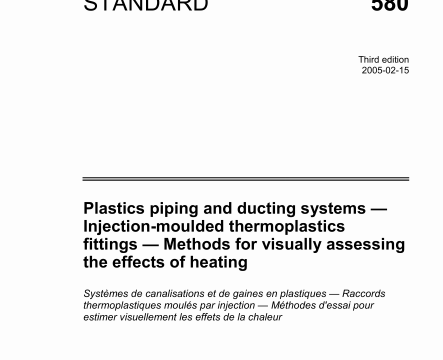ISO 580 pdf download – Plastics piping and ducting systems —lnjection-moulded thermoplastics fittings – Methods for visually assessing the effects of heating.
4.3.3 Leave the test pieces in the oven until the oven returns to the test temperature (TI 2) C and for a further period, r. dependent on the mean waf thickness, em, of the thickest part of the test piece(s) in accordance with the product standard or Table 1.
4.3.4 Remove the test pieces from the oven, taking care not to deform or damage them.
4.3.5 Cut the test pieces with a sharp knife or razor blade while they are still hot, to enable the dimensions of cracks, blisters, delaminations and weld-line openings, if any, to be measured as required. Allow the test pieces and/or parts therefrom to cool in air until they can be handled without deformation.
If not otherwise specified in the referring standard, the following number of cuts should be made:
— for cylindncal components of d 160 mm. not less than two cuts equaly spaced around the periphery of the mouth of each socket or spigot of the component.
— for cylwidncal components otd> 160 mm, not less than four cuts equally spaced around the periphery of the mouth of each socket or spigot of the component
For d. see Figure 1.
4.3.6 Examine each test piece for, and record, any surface changes. such as cracks, delaminations and weldline openings as well as changes inside the wall. e.g blisters, and in the gating area Determine the extent of such defects in the gating area as a percentage of the wall thickness as follows.
a) For sprue-gated mouldings (see Figixe 1): around the injection point(s) within a radius as specified in the referring standard. In the absence of any information in the referring standard. use R = O,34 with a maximum value of 50 mm
b) For ring- or diaphragm-gated mouldings (see Figure 1): wfthln a length. L, of the cylindrical portion of the gating area as specified in the referring standard or, in absence of any information, within a length L = 0,3d,. In the case of cracks running through the whole wall thickness of the gating area, determine also the length of the crack.
c) For moulngs containing fusion lines, determine the widest and deepest part(s) of any open part of the fusion line.
d) For all other parts of the moulding beyond the gating area, examine the surface for any change, such as cracks, blisters, and delaminations of the wall.
If not specified in the referring standard, the specifications given ii Annex A should be used for the examination of a test piece.
If not otherwise specified in the refernng standard, when examined for signs & cracks, delaminahons, blisters and fusion line opening, the fining should satisfy the following:
— around the Injection point(s), within the radius specified In 43.6 a), the depth of any single crack, delamination or blister shall not be more than 50 % of the wall thickness at that point
— for diaphragm-gated niouldings, any crack, delamination or blister shall be within the length specified in 4.16 b);
— for rlng-gated mouldings, the distance from the ring gate of any cracks in the wall of the mouldings shall not be more than the length specified in 43.6 b) and their depths shall not be more than 50 % & the wall thickness;
— for mouldings containing fusions, no part of the fusion shall be open by a distance of more than 50 % of the wall thickness,
for all other parts of the moulding surface, the depth of any single crack or ddan’iinatiort shall not exceed 10 % of the wall thickness and the length of blisters in the wall of the mouldings shall not exceed 5 times the wall thickness.
For specific applications, more stringent specifications may be adopted it required by the particular product standards.
ISO 580 pdf download – Plastics piping and ducting systems —lnjection-moulded thermoplastics fittings – Methods for visually assessing the effects of heating
